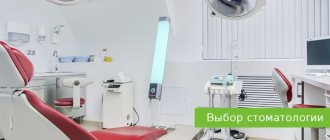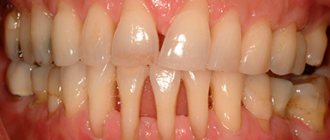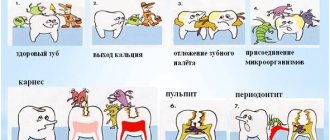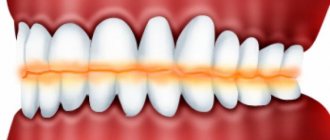Why are teeth drilled?
In dentists' language, drilling teeth means preparing. The doctor removes tooth tissue damaged by caries before placing a filling. However, teeth are drilled not only for treatment.
The tooth may be prepared to be covered with a crown. Prosthetics are needed if the doctor sees that restoring a tooth with a filling is unreliable. For example, when it is a front tooth and there is a risk of chipping due to increased load. Another reason is the small volume of healthy tissue. If the patient has deep caries, and even more so pulpitis, tooth restoration with a crown is indicated. In this case, the dentist drills the tooth in several stages. The doctor dissects it to remove caries-affected tissue to open the pulp chamber, gain access to the canals and widen them. At the last stage, after removing the nerve and treatment, the dentist drills the tooth, grinding it down for a crown.
The doctor is sometimes forced to dissect even healthy (without caries) and living (with nerve) teeth. This happens when veneers are placed. They are ceramic overlays for teeth. It happens that the front teeth are too small or there are large distances between them. It happens that a spot appears on a tooth due to fluorosis, enamel hypoplasia, or trauma. Sometimes a small part of the front tooth breaks off or the cutting edge wears off. There are simply very demanding patients when it comes to aesthetics. They want their front teeth to be the same shape, size and perfect appearance. In all these cases, installation of veneers is possible. Their advantage is that the tooth remains alive. It is not depulped and a small layer of enamel is removed (ground down).
The use of pin and stump inlays when restoring “dead” teeth
At the beginning of the article, we said that removing the nerve (pulp) deprives the tooth tissue of recharge. In addition to deteriorating the adhesion of dental materials, removing the nerve makes the tooth tissue dry and brittle, and the expansion of the canals during their treatment further weakens the tooth walls.
To make the roots of the tooth stronger, before restoring the tooth, reinforcement of the roots is performed with fonts.
If the supragingival part of a tooth is completely destroyed, then pin-and-stump inlays manufactured in a dental laboratory are used to create a tooth stump, on which a crown is then installed.
Now let’s look at what options there are for restoring “living” teeth.
Drill teeth without pain
Some, especially the older generation, tell how they were treated without anesthesia not only for caries, but also for pulpitis. The doctor, by the way the patient twitched sharply, determined that the instrument had reached the nerve. Now everything is completely different. Anesthesia has become the standard in dentistry, with pain relief for both teeth drilling and extraction.
This is necessary, first of all, so that the patient in the dentist’s chair does not experience stress. Anesthesia also makes the doctor’s work more convenient. When the dentist just begins to dissect, it does not hurt the patient because there are no nerve endings in the enamel. But when the doctor approaches the enamel-dentin border, the person can jerk sharply in pain, and the dentist can damage the mucous membrane with the instrument.
Don't be afraid that the injection won't work. All modern anesthetics relieve pain equally well, and it does not matter how old a person is, what ailments he has or what medications he takes. A medicine can only “fail” if the doctor injects it in the wrong place. This happens either because the dentist is inexperienced, or because the nerve bundle runs slightly in a different place than usual. In such cases, they simply do it again in the right place.
Drilling teeth with an injection does not hurt. However, the patient feels the way the teeth are drilled, i.e., the vibration of the rotating instrument. The anesthetic blocks the type of nerve fibers that are responsible for pain. Completely different (proprioceptive) receptors are responsible for the sense of pressure and vibration. Fortunately, these sensations do not cause discomfort.
Laser
A person consists of 60-70% water. There is water in the teeth too. Laser tooth preparation is based on the fact that the laser beam causes water to boil in the tooth tissue. A series of micro-explosions occur in the enamel and dentin, and they begin to flake off.
Various types of lasers in dentistry are used to perform operations, treat caries and its complications, and clean and whiten teeth.
How effective? Honestly, I don’t know, I haven’t seen laser work. And I won’t say more about this, lest it turn out like the joke:
– And what did everyone find in these “Beatles”? I heard them. They burr, they fake it, their English is so-so. -Where did you hear them? - Yes, my neighbor sang to me!
No, I’ll still say a few words: there are contraindications, consultation with a specialist is necessary.
Anesthesia
Let's look at what else people are afraid of when they hear about pain relief.
- Pain from the injection. There are patients, especially children, who are frightened by the very injection of an anesthetic with a syringe. Doctors know about this, so they pre-lubricate the injection site with anesthetic gel. It reduces discomfort to a minimum. But it must be said that a good doctor makes the injection almost unnoticed.
- Allergy to anesthetic. The likelihood of its occurrence is negligible, much lower than the likelihood of food poisoning.
- Short duration of action of the anesthetic. Some are afraid that the “freezing” will disappear before the dentist finishes the work and pain will appear. Indeed, the duration of action of an anesthetic injection may vary slightly from person to person. The anesthetic will “work” faster in those who have better blood circulation in the area of pain relief. These same patients are more likely to “come away” from the injection. A doctor cannot predict this, but a good specialist is always interested in the patient’s feelings. If the analgesic effect decreases, the dentist transfers the next stages of work to another appointment.
- Side effects of anesthesia. Sometimes patients complain that immediately after the injection their arms and legs begin to tremble, their heart rate increases, etc. This reaction is caused by adrenaline in some anesthetics. In this case, the doctor selects another drug, without adrenaline or with a reduced content of it. There are plenty of such options, they are also used for children. Occasionally it happens that due to “freezing” a person’s eye cannot close. Don't be alarmed: this will go away as soon as the anesthetic wears off. It's all about the proximity of the anesthetized nerve to the optic nerve.
How long does it take to drill teeth?
It must be said that dental treatment is not always possible in one visit. And the reason for this is not the slowness of the dentist, but the careless attitude or fear of the patient, because of which he postpones the visit to the doctor.
Caries, when there is no need to depulpate the tooth (remove the nerve), is treated in one visit. Pulpitis is treated in two visits. After removing the nerve and cleaning the canals, the dentist places a temporary filling, and a medical pad under it. The patient is released for about a week. The next time the doctor asks if the tooth hurt. If not, then the channels are cleaned well. They can be filled and the tooth can be restored with a permanent filling.
It happens that the patient has brought the tooth to periodontitis, that is, when the inflammation has already spread to the tissues around it. Then the dentist injects medicine into the canals. After a few days, repeat the procedure, and so on several times, until the inflammation disappears. Further treatment is the same as the treatment of pulpitis.
Restoring a tooth with a filling, even without pulp removal, can be lengthy. How long it takes to drill a tooth depends on the size of the carious cavity. It often happens that a tooth is affected from several sides, for example, on the chewing surface and in the interdental space. In this case, the dentist creates several cavities for fillings. A lot of time is spent making the tooth indistinguishable from natural, healthy teeth. This is why doctors prefer to call the treatment aesthetic restoration. Of course, you can drill out a tooth and close it with a filling in 5 minutes, but high-quality work, when attention to detail is paid, takes 30 or 60 minutes.
Tools
What does a dental therapist use to drill teeth? The working tool is a turbine tip. Thanks to the motor, it rotates at a speed of 200-500 thousand revolutions per minute. More powerful tips have a larger head. A bur (diamond, steel or alloy) is installed in it. Burs come in different abrasiveness, shape, and size. This is determined by purpose. The turbine tip has a cooling system, and modern samples have a backlight.
How is a tooth treated?
Let's consider the stages of caries treatment, i.e. the situation when the tooth remains alive (with a nerve) and the canals are not filled.
When the anesthetic has taken effect, a rubber dam is placed on the tooth. This is a thin elastic film that protects the tooth from saliva or gum fluid.
The dentist drills out all tissues damaged by caries and creates a cavity for the filling. He then applies the etchant to the tooth for 10 to 40 seconds. This is a substance (acid) that removes sawdust after drilling and makes the tooth surface rough for better adhesion.
After washing off the etching, the doctor applies fluoride varnish, which strengthens the dentin and reduces tooth sensitivity. The next step is to apply bonding. This is a substance for the ligament of the tooth with the filling, which penetrates the dentinal tubules. To make the bonding harden, it is illuminated with a helium lamp. Its rays are harmless, it is just a blue LED lamp.
To place a filling, the dentist needs several types of filling material because different parts of the tooth have different colors and translucencies. The doctor applies an opaque dentin-colored material and illuminates it. A transparent layer (enamel) is applied to the incisal edge and exposed. Next, the doctor, to make the tooth look natural, forms the longitudinal ribbing of the tooth (mamelons). If the tooth is chewing, it creates grooves (fissures) between the cusps. Lights it up, removes the rubber dam and polishes it. Grinding is necessary not only for the beauty and shine of the tooth, but also so that plaque sticks to it less.
Next, the dentist checks the height of the filling. He places special paper, similar to copy paper, on the tooth. The patient makes several chewing movements, and imprints remain on the teeth at the points of contact. Using them, the doctor determines whether the filling is too high or too low. Makes changes if necessary. If this is not done, the filling will interfere with chewing and the bite will be disrupted.
Causes of holes in teeth
There is no one exact reason why a black hole forms in a tooth. Scientists and specialists identify a number of factors and their combinations that cause dental decay. The most probable and popular is the modern theory of the occurrence of caries. It is based on the effect on the enamel of a complex of pathogenic factors - dental plaque, carbohydrates and microorganisms. Dental plaque creates a favorable environment for the growth and development of microbes that process simple carbohydrates and produce acids. The latter, in turn, damage the enamel and provoke its progressive destruction with the formation of a defect.
Read also: Why Hitler needed Antarctica
Other causes of the disease include:
- Genetic predisposition;
- Insufficient or poor hygiene care;
- Using inappropriate products and techniques for brushing teeth;
- Laziness of chewing, eating mostly soft foods;
- Diseases of the salivary glands;
- Violation of the composition of saliva;
- Somatic diseases of the body;
- Hormonal disbalance;
- Metabolic disease;
- Serious pathologies of the body.
Features of children's treatment
If the parent himself is afraid of the dentist and scares the child with him, then visiting the doctor will be problematic. Show that you treat visiting the doctor as something routine. Tell them that all your relatives and friends go to the dentist. If possible, take your child with you to your appointment. Play treatment at home, don’t tell them how teeth are drilled, but count them, look at them in the mirror.
On the day of your visit to the doctor, do not be too affectionate and do not shower him with gifts. This will alert the child. Don't threaten punishment. Don't come too early, don't sit in the hallway, because the baby may get upset because of the crying children.
A good pediatric dentist will never drill a child’s tooth out of the blue. He will talk to the baby using the definitions available to him. For example, do not drill, but buzz, do not give an injection, but smear with cold ice cream, do not treat, but take out the worm from a tooth, do not put a filling, but cover it with chewing gum. Expensive private clinics even offer an adaptation service, where the doctor plays with the child, teaches how to brush teeth, etc.
Local anesthesia is required; the baby should not feel pain. But please note that the clinic must have a license for children's treatment. Different dentists approach general anesthesia differently. It can be avoided in 99% of cases. Sedation is justified if a child with a strong gag reflex is undergoing treatment of lateral teeth, if the child is uncontrollable, if the previous treatment caused him severe psychological trauma.
Make an appointment
Center for Aesthetic Dentistry
Center for Aesthetic Dentistry (m. Universitet, Prospekt Vernadskogo, 11/19) Center for Dental Implantology (metro Krasnye Vorota, Sadovaya-Spasskaya St., 19) Center for Dental Implantology (m. Paveletskaya/m. Novokuznetskaya, Ozerkovskaya embankment , no. 26) Center for Aesthetic Dentistry on Chistye Prudy (metro Chistye Prudy, Maly Kharitonyevsky Lane, no. 8/18) DentalGeneva Clinic (Boulevard James-Fazy 4, 1201 Geneva) “Aesthetic Dentistry” on Patriarch’s Ponds (metro Tverskaya , Malaya Bronnaya, 26)
By clicking the “Submit” button, I agree to the processing of my personal data in accordance with the Privacy Policy
Close
Is it harmful to drill your teeth often?
Drilling teeth damaged by caries is not harmful, but necessary. Even a person who is careful about their oral hygiene may need treatment, and here's why. In the cervical areas, in the fissures of the lateral teeth, plaque accumulates faster due to limited access. In addition, the layer of enamel in these areas is thinner than, for example, on the masticatory hillocks. The emerging caries may not be noticeable to the patient, but it develops quite quickly.
It happens that a person sees a tiny dark spot on a tooth, and the doctor has to drill out a huge cavity and cover it with a large filling. How does this happen? The fact is that enamel is the hardest tissue in the body. Caries affects it more slowly than the dentin located along it. A small entrance hole in the enamel leads into a large cavity in the dentin.
If a person goes to the dentist because a tooth begins to hurt, it means that inflammation has begun, i.e. pulpitis. In this case, you will need to drill more. We can conclude that teeth are drilled more often in those who do not see a doctor on time or ignore preventive examinations.
Why are impacted teeth problematic?
What teeth are called impacted? These are units that, for certain reasons, did not cut through. In most cases, the “eight” is such a tooth, since it erupts quite late and by that time there is no free space in the jaw.
Considering that such teeth are not involved in the process of chewing food and at the same time become the cause of inflammation in the future, it would be more advisable to remove them.
Read also: What to eat before and after the pool?
The difficulty of removing an impacted tooth is explained by the fact that in order to open access to them it is necessary to disrupt the integrity of the gums due to its inconvenient location. The procedure can last up to an hour or longer.
Extraction procedure
The stages of removing an impacted tooth are as follows:
- an incision is made on the gum;
- the surgeon drills a hole in the bone;
- the problematic tooth is pulled out;
- all remaining bone fragments are removed from the socket;
- the wound is treated with an antiseptic solution;
- stitches are placed.
Immediately after the procedure, it is advisable to apply cold to the cheek, which accelerates the formation of a blood clot. This will prevent the wound from becoming infected. If necessary, the doctor may also prescribe anti-inflammatory drugs.
Expert advice
Before starting treatment, a good doctor always explains what he will do and why. Don't hesitate to ask your dentist anything you don't understand. A professional doctor is interested in caring patients. In addition, you must clearly articulate what results you expect from the treatment.
Describe your fears to the dentist. People are often afraid of the unknown, so the doctor should dispel doubts with his explanations, and also do everything to make you feel comfortable. If you trusted a specialist and agreed to treatment, then follow the doctor’s requests during the process.
Sometimes after filling there is a reaction to hot and cold. This is due to the fact that the filling material has a higher thermal conductivity than the tooth. In this case, the doctor uses a sealant. Another option is to wait; the sensitivity will decrease on its own over time. In six months everything will be as before. If after filling the tooth begins to react to acid, go to the dentist. This reaction indicates a leak in the filling.
Prevention of caries
A child who is teething needs to be seen by a pediatric dentist once. The doctor will check that everything is going as it should. Until the age of three, it is enough to come for an examination once a year. After three years, a child, like an adult, should visit the dentist twice a year.
Brush your teeth twice a day with a soft or ultra-soft toothbrush and low-abrasive toothpaste. Thanks to such a brush, you will never have a wedge-shaped defect, when the enamel in the cervical part of the tooth is erased due to excessive pressure. Brushes with bells and whistles don't make sense. The most important thing is the size of the head. The smaller the number, the more convenient and better the cleaning. For patient perfectionists, there are mono-tuft brushes. They clean best, but take a long time.
Children's teeth should be brushed from the moment they appear. When the child is too small, an adult does this with a fingertip. Children 3-4 years old can be taught high-quality cleaning using plaque detection indicators. These are chewable tablets or lozenges that color the plaque blue or red.
Thin dental floss will help remove plaque between the teeth and under the gums. Some complain that it injures the interdental papillae. In this case, you can use interdental brushes. The irrigator allows you to brush your teeth even better. It is especially needed for people with braces. All this, coupled with regular (twice a year) professional cleaning at the dentist, gives excellent results.
Don’t think that drilling a tooth is painful, because it is done under local anesthesia. If the doctor refuses to give an anesthetic injection, do not agree and go to another specialist. A good doctor will never put a patient under stress.
Caries in the spot stage
Initial stage of caries. Characterized by the appearance of spots on the enamel. In the demineralized area, damage to the enamel structure is observed. As a rule, patients cannot detect it themselves.
The spot may be white or pigmented. If a brown or black stain is easy to notice, then a coated stain can only be diagnosed using an aqueous solution of methylene blue.
Important. With timely treatment, remineralization therapy can be carried out and tissue can be restored. This is why experts recommend visiting the dentist once every six months - in order to take timely measures and prevent caries from developing.
The carious spot is treated with solutions of sodium fluoride and calcium fluoride. The patient is prescribed vitamins, calcium and phosphorus supplements, and brushing teeth with fluoridated toothpaste is recommended. Your doctor may also recommend a special diet that includes foods high in calcium and certain proteins.











